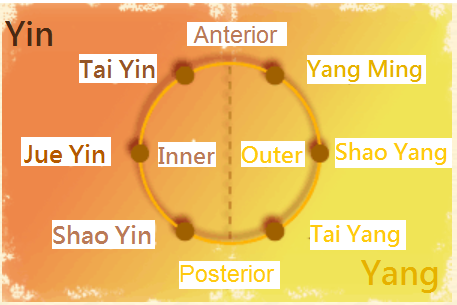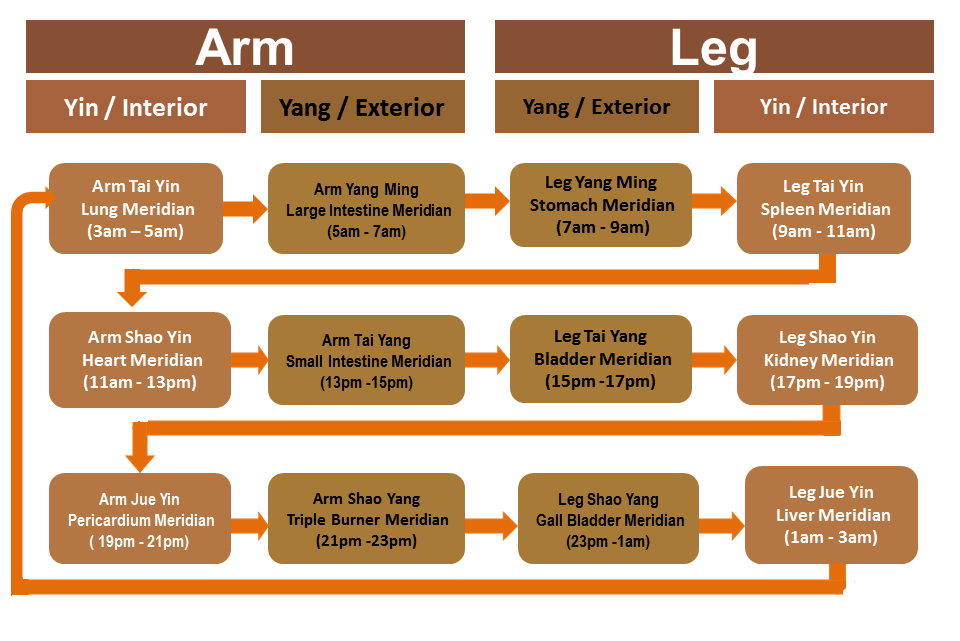Distribution of Twelve Regular Meridians in Body
- About the names of twelve regular meridians
- Distribution of the twelve regular meridians in the body
- Meridian flow chart and qi current time schedule
- The exterior-interior relationship in the meridians
About the Names of the Twelve Regular Meridians
The twelve regular meridians start and end at specific body locations, their pathways and interconnections are in precise manners, also each of the meridian branches out to connect an organ directly. They are named according to their corresponding organs, limb positions and yin and yang properties.| Sequences | Arm / Leg | Yin / Yang | Corresponding Organs |
|---|---|---|---|
| 1 | Arm | Tai Yin | Lung |
| 2 | Arm | Yang Ming | Large Intestine |
| 3 | Leg | Yang Ming | Stomach |
| 4 | Leg | Tai Yin | Spleen |
| 5 | Arm | Shao Yin | Heart |
| 6 | Arm | Tai Yang | Small Intestine |
| 7 | Leg | Tai Yang | Bladder |
| 8 | Leg | Shao Yin | Kidney |
| 9 | Arm | Jue Yin | Pericardium |
| 10 | Arm | Shao Yang | Triple Burner |
| 11 | Leg | Shao Yang | Gall Bladder |
| 12 | Leg | Jue Yin | Liver |
Distribution of the Twelve Regular Meridians in the Body
The twelve Meridians run through the body bilaterally, and are distributed symmetrically on the head, face, trunk and limbs. The six yin meridians are distributed on the inner side of the limbs, the chest and abdomen. The six yang Meridians are distributed on the outer side of the limbs, the head, face and trunk. The following illustrated the general distribution of the twelve meridians on the limbs. 
Yin Yang positions around the limbs
As shown in the diagram, the order and arrangement of the three yang meridians for both arms and legs are as follows:
a) Yang Ming (meaning sunlight yang) has an anterior position.
b) Shao Yang (meaning lesser yang) has a middle position.
c) Tai Yang (meaning greater yang) has a posterior position.
The three names have described the wax and wane of yang. They can also be interpreted as describing the variation of sunlight received. Since most animals' backs receive the greatest amount of sunlight, the back or posterior region is usually named as the Tai Yang position. Similarly, the position of Shao Yang and Yang Ming are located at more anterior regions where less sunlight is received.
The order and arrangement of the three yin meridians are as follows:
a) Tai Yin (meaning greater yin) has an anterior position.
b) Jue Yin (meaning absolute yin) has a middle position.
c) Shao Yin (meaning lesser yin) has a posterior position.
Again, the three names have described the wax and wane of yin and the degree of darkness at that position.
Meridian Flow Chart and Qi Current Time Schedule
Qi (vital energy) flowing in the twelve regular meridians follows specific time schedules and pathways. As TheYellow Emperor’s Classic of Internal Medicine says, "The three yin of the arms go from the organs to the hands. The three yang of the arms go from the hands to the head. The three yang of the legs go from the head to the feet. The three yin of the legs go from the feet to the abdomen." Qi is continuously circulating through the meridians in a daily cycle. At certain times, both qi and blood have maximum flow in particular meridians which are outlined below. 
Daily qi current of the 12-hour division
As shown in the above chart, qi is more prevalent in different meridians at different times. For example, from 3am to 5am, meridian qi mainly flows through the Lung Meridian and enters the Large Intestine Meridian at 5am〜7am, and then the Stomach Meridian from 7am〜9am. In this way, the twelve meridians become one continuous pathway for qi and blood flowing throughout the body.
The Exterior-interior Relationship in the Meridians
As mentioned before, meridians are classified into yin meridians and yang meridians according to the yin or yang organs with which they are connected. TCM believes the interior belongs to yin and the exterior belongs to yang. Hence, yin organs are thought to have more internal functions and are called interior organs (zang). The yang organs, on the other hand, are believed to have more external functions and are considered exterior organs (fu). TCM analyzes the physiological function of the body based on the harmonious relationships between yin and yang organs. One yin meridian and one yang meridian are further interconnected through their divergent channels and connecting collaterals. The six meridian pairs usually join and contact in the extremities, then run in parallel along the inner and outer sides of the arm or the leg. When entering into the trunk, the meridians will branch out to reach their corresponding organs (see the table below). In this way, the two paired meridians are more closely communicated, and the corresponding organs are more related physiologically and pathologically. The concept of interior and exterior relationship was established then, which becomes an important guidance for TCM practice.
For example, spleen and stomach are paired, the spleen is responsible for transformation and transportation pure essence, the stomach is responsible for receiving and ripening ingested food and fluids, the two organs are functional coordinated in each other. Lung and Large intestine are paired, the lung’s disseminating and descending functions help the large intestine to transmit the digested wastes, and vice versa. Pathologically, the paired organs are more likely to interact with each other too, for example, fire in the heart can easily flow down to the small intestine; a stagnated gall bladder usually resulted from liver failure in regulating qi; constipation can be due to abnormal qi movement in the lung.
During clinical treatment, acupoints on one meridian can be cross used to treat problems in its paired meridian, e.g. acupionts along the lung meridian are selected for the treatment of the large intestine or large intestine meridian. And in herbal applications, soothing liver to facilitate bill secretion, inducing urination to clear heart fire, and regulating lung qi to promote bowel movements, are all based on this guidance.
| Yin Meridians (connected zang organs) | Yang Meridians (connected fu organs) | Pathways (yin/inner side, yang/outer side) | ||
|---|---|---|---|---|
| ARM | Tai Yin Lung Meridian | Yang Ming Large Intestine Meridian | Upper Limb | Anterior |
| Jue Yin Pericardium Meridian | Shao Yang Triple Burner Meridian | Lateral | ||
| Shao Yin Heart Meridian | Tai Yang Small Intestine Meridian | Posterior | ||
| LEG | Tai Yin Spleen Meridian | Yang Ming Stomach Meridian | Lower Limb | Anterior |
| Jue Yin Liver Meridian | Shao Yang Gall Bladder Meridian | Lateral | ||
| Shao Yin Kidney Meridian | Tai Yang Bladder Meridian | Posterior | ||


